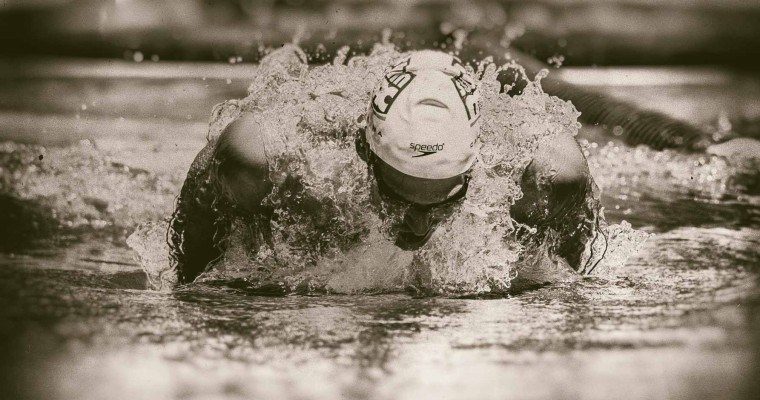Courtesy of Gary Hall Sr., 10-time World Record Holder, 3-time Olympian, 1976 Olympic Games US Flagbearer and The Race Club co-founder.
At The Race Club, we pride ourselves in teaching fundamentals and paying attention to details. In order to excel in swimming, arguably the most technique-sensitive sport of all, one needs to be mindful of millimeters, degrees and tenths of seconds. A few millimeters away from the correct head or elbow position, a few less degrees of ankle flexibility or hip rotation, a few tenths of seconds in delay of a pull or a kick can lead to…well, the loss of a race.
Understanding the fundamentals of swimming requires knowledge of the basic scientific laws that govern the technical aspects of our sport. For the most part, these laws for the underwater and surface movements are Newton’s three laws of motion, redefined for a swimmer.
Newton’s Laws Of Motion
The force that Newton defines in his second law of motion, the vector sum of the propulsive forces (those that propel us through the water) and the drag forces (those that slow us down) ultimately determines our body speed or acceleration in the water. While it seems desirable to maximize propulsive forces and minimize drag forces, the reality is that we can’t always have it both ways. That is what makes swimming such an interesting sport from a technical standpoint. The motions of maximum propulsion do not agree with the motions of minimal drag…so we learn to compromise. And we learn that although there are commonalities of good technique, there is not necessarily one single best way of swimming fast for all swimmers and for all distances.
The Bernoulli Effect
There are other laws that affect a swimmers speed, such as the Bernoulli effect, that likely provides some lift (upward force) to a swimmer, or the law of conservation of energy that impacts the way we recover with our arms, head and body above the water.
In considering all of the motions of a swimmer that may improve the likelihood of swimming fast, one must also consider the biomechanical impact of those motions. Will they lead to injury? After all, as human beings, we are really not well engineered for moving fast in the water. So in redefining ourselves as aquatic mammals, we must be careful to consider all aspects of strength, flexibility and motions in our endeavor to swim fast safely.
I hope that you will enjoy some of the discussion we have in our Race Club fundamentals lecture where we share some ideas on how to reduce frontal drag, how to increase propulsive forces and how to best obey that immutable law of inertia. You will find it on the link below.
FUNDAMENTALS OF FAST SWIMMING, Gary Hall Sr., The Race Club
Yours in swimming,
Gary Sr.
https://www.facebook.com/theraceclub
http://instagram.com/theraceclub
https://twitter.com/theraceclub
https://www.linkedin.com/pub/gary-hall/9/908/671
[email protected]
Www.theraceclub.com
The Race Club
Because Life is Worth Swimming, our mission is to promote swimming through sport, lifelong enjoyment, and good health benefits. Our objective is for each member of and each participant in The Race Club to improve his or her swimming performances, health, and self-esteem through our educational programs, services and creativity. We strive to help each member of The Race Club overcome challenges and reach his or her individual life goals.
The Race Club provides facilities, coaching, training, technical instruction, video, fitness and health programs for swimmers of all ages and abilities. Race Club swim camps are designed and tailored to satisfy each swimmer’s needs, whether one is trying to reach the Olympic Games or simply improve one’s fitness. Our programs are suitable for beginner swimmers, pleasure swimmers, fitness swimmers, USA swimming or YMCA swimmers, or triathletes; anyone who wants to improve swimming skills. All of our Race Club members share an enjoyment of being in the water and use swimming to stimulate a more active mind and body.



I LIKE ORANGES
with all due respect to the author, the physics aspect of the article is way off at best.
firstly, when swimming through with matter relatively high density (=water), we must take into account the drag that correlates with our speed.
So for high values of Reynold’s number, we apply the Stokes law of resistance, which states that the force we feel is equal to density*surface*coeficient of drag (depends on the shape of the object)*(speed^2). which equals mass*acceleration.
we get a differential equation that gives us an exponential correlation. the value that our function comes close too, but never reaches is called terminal velocity (you might have heard off that) and is the highest velocity that our object… Read more »
The entire cosmos and our milky way ( and I am not talking about chocolate milk here) is governed by gravity – and so is swimming. Very few coaches keep that in mind and apply basic laws of physics.
Damn it Dad, you were doing so well. You had a funny, relevant post that wasn’t demeaning or belittling and then you had to go and ruin it.
Since you brought it up, I’ve been meaning to ask you this – When falling freely, gravity pulls down at a speed proportional to the time spent falling – how does this apply to swimming? Ostensibly, if gravity had any measurable impact in swimming, any meet held near the equator should be slower than a meet held closer to the poles because the force is weaker, correct? Should swimmers start to adjust their technique based on latitude?
I don’t know how serious you’re being, but gravity pulls down with the same force regardless of how fast you’re going, how long you’ve been falling, or whether you are standing or swimming.
Also gravity is strongest at the poles, not weakest. The weakest gravity is at the top of extremely tall mountains near the equator. According to Wikipedia, the weakest point is at the top of a mountain in Peru: http://en.wikipedia.org/wiki/Gravity_of_Earth#Variation_in_gravity_and_apparent_gravity
Since you brought it up though, I’m really curious what swimming would be like in low or high gravity! What if we put a pool on the moon? How much faster would swimmers go? It’s hard to reason about the effects I think, but they should be faster!
I meant to say you speed up the longer you’ve been falling, not that the force changed and I admit I reversed the weak/strong at the poles. Oops. I still don’t see how it has an impact on swimming.
Even further, if you swim so that you can actually bend time (and therefore swim faster) in compliance with general theory of relativity, that is the ultimate goal. 🙂
Wow, I did a little research on Gary Hall, St after reading this article and was very impressed to learn he continued his swimming career while attending medical school, won a medal (in 3 different events actually) in 3 consecutive Olympics, and together with his son are the only father/son duo to have accomplished that feat! Impressive!
I didn’t know he was a co-founder of The Race Club with his son! Together they have Olympic medals to prove their expertise in every stroke and distance event!
Mrs. Hall?